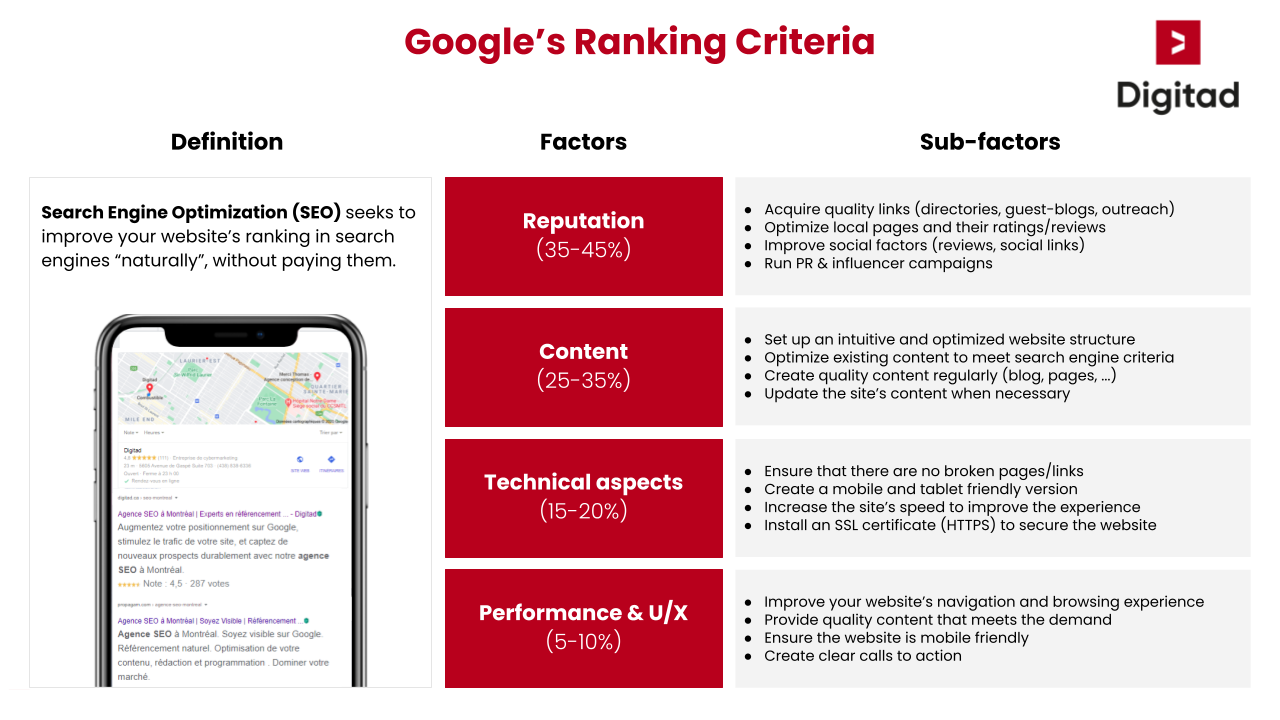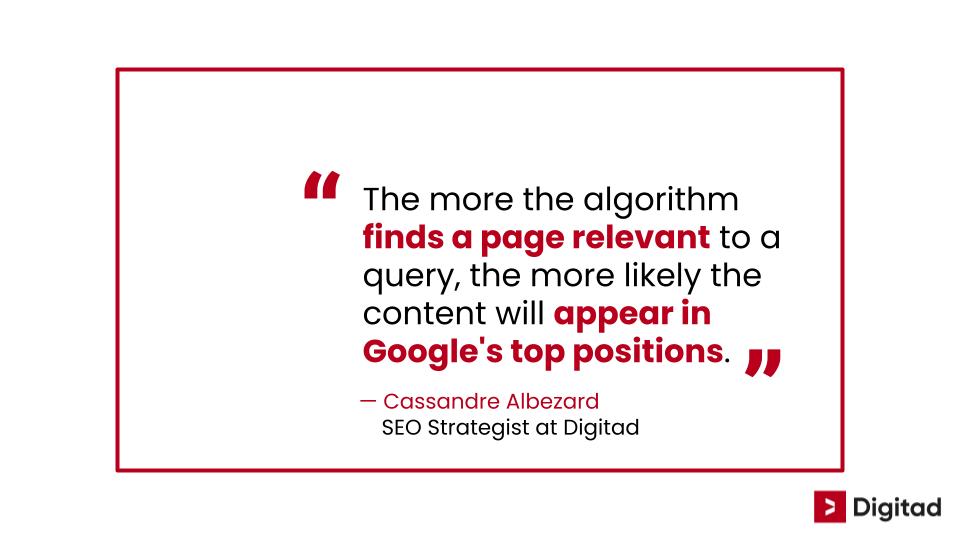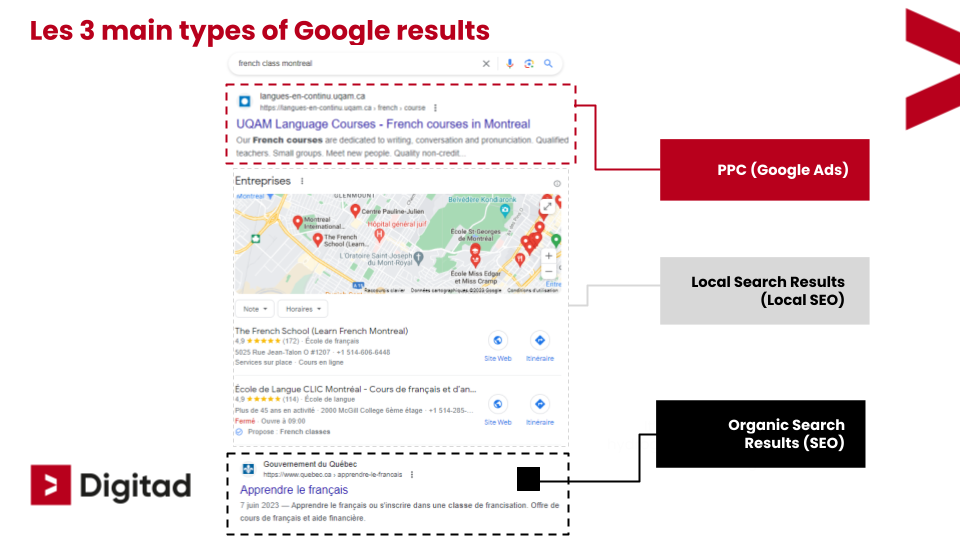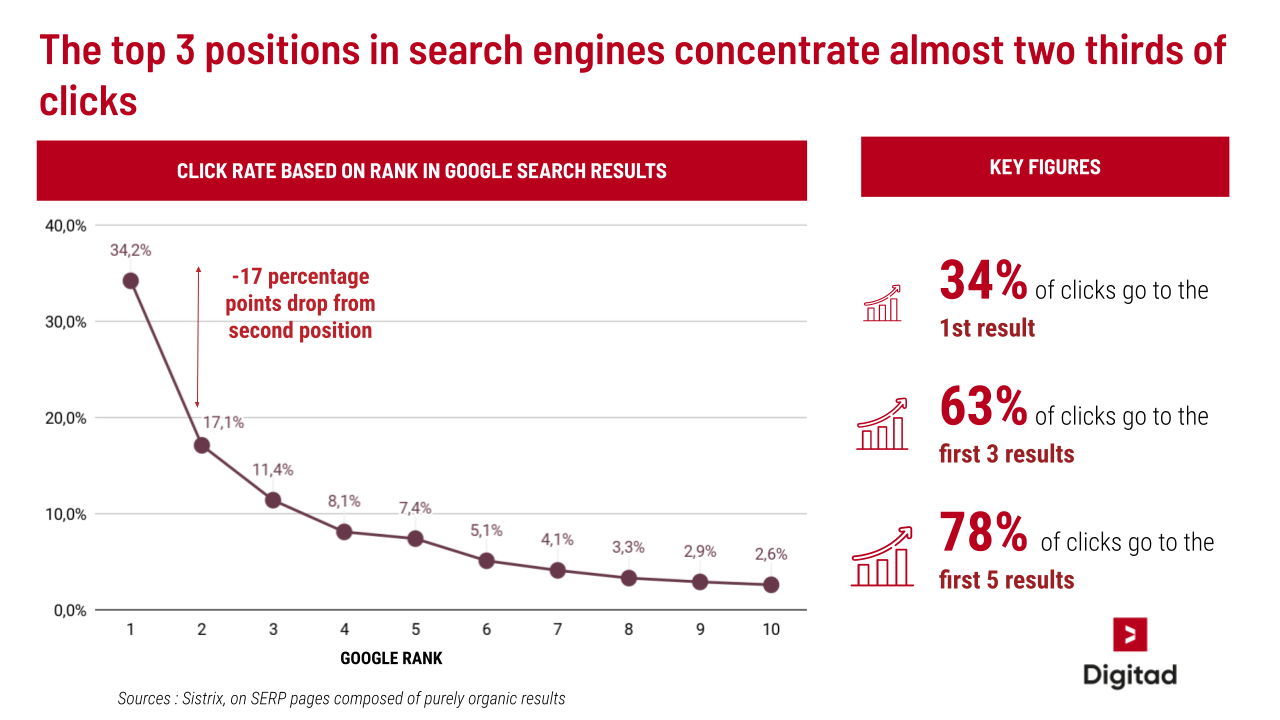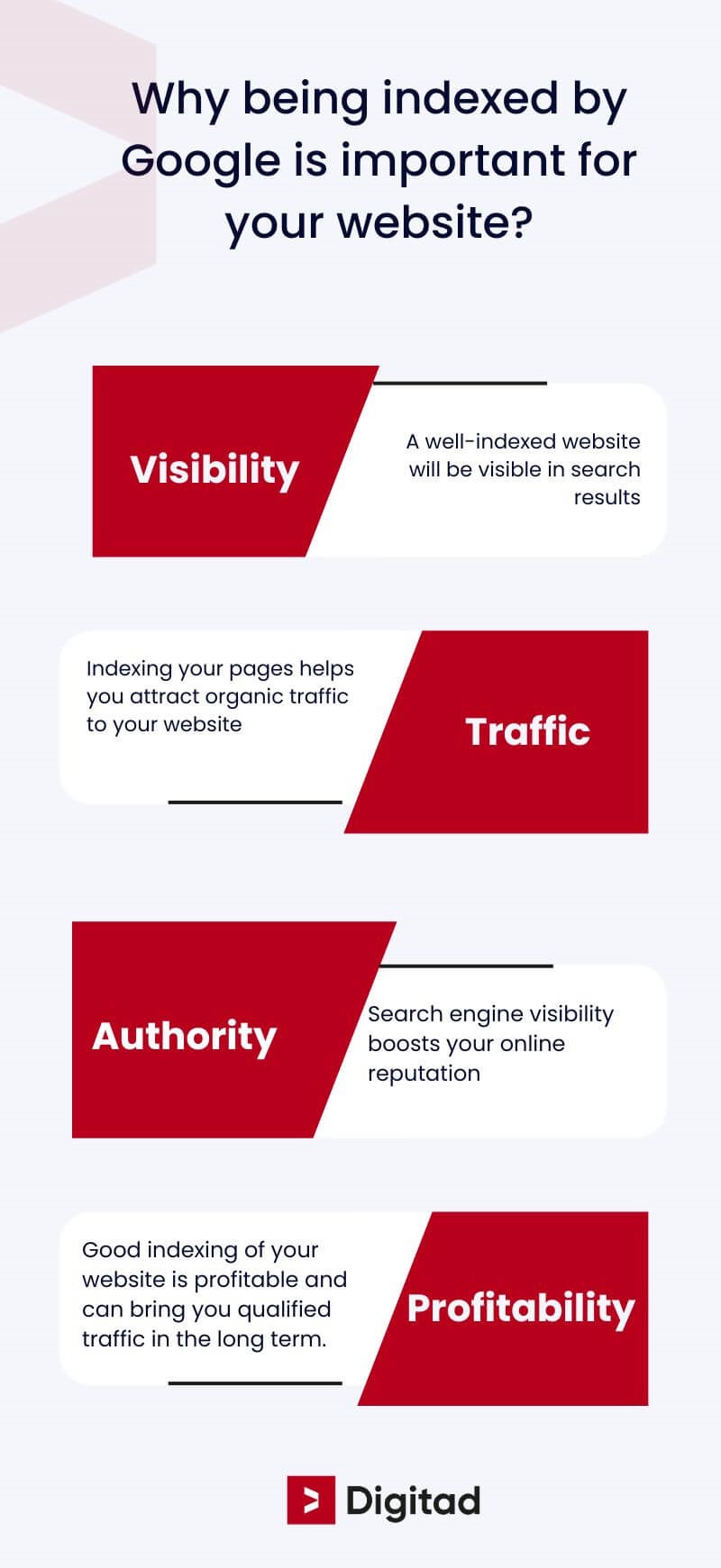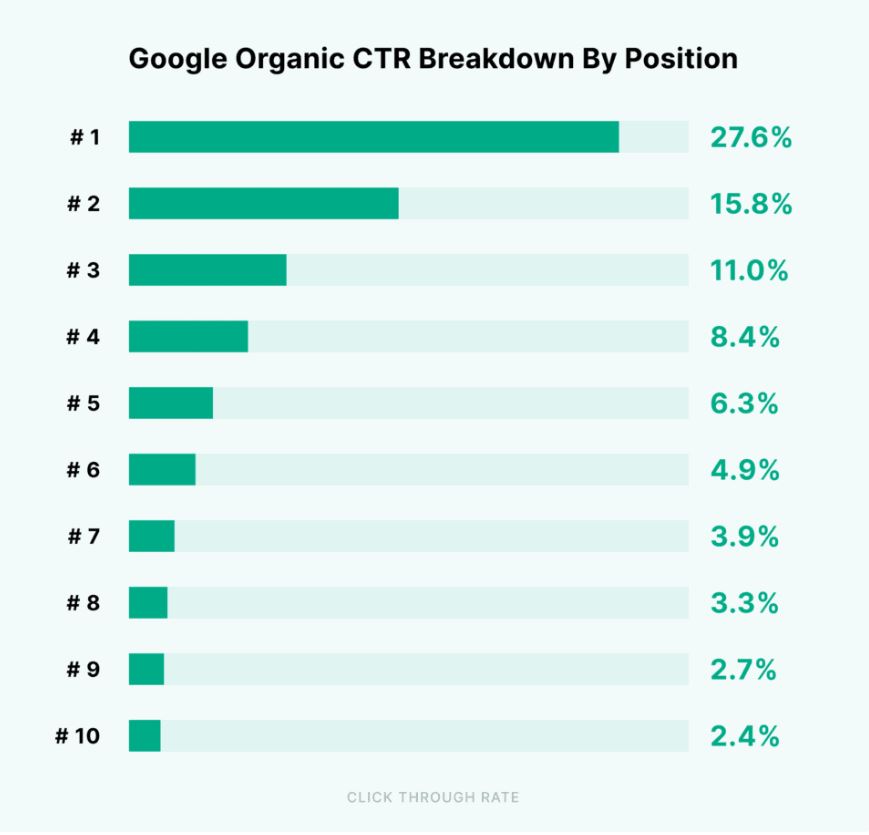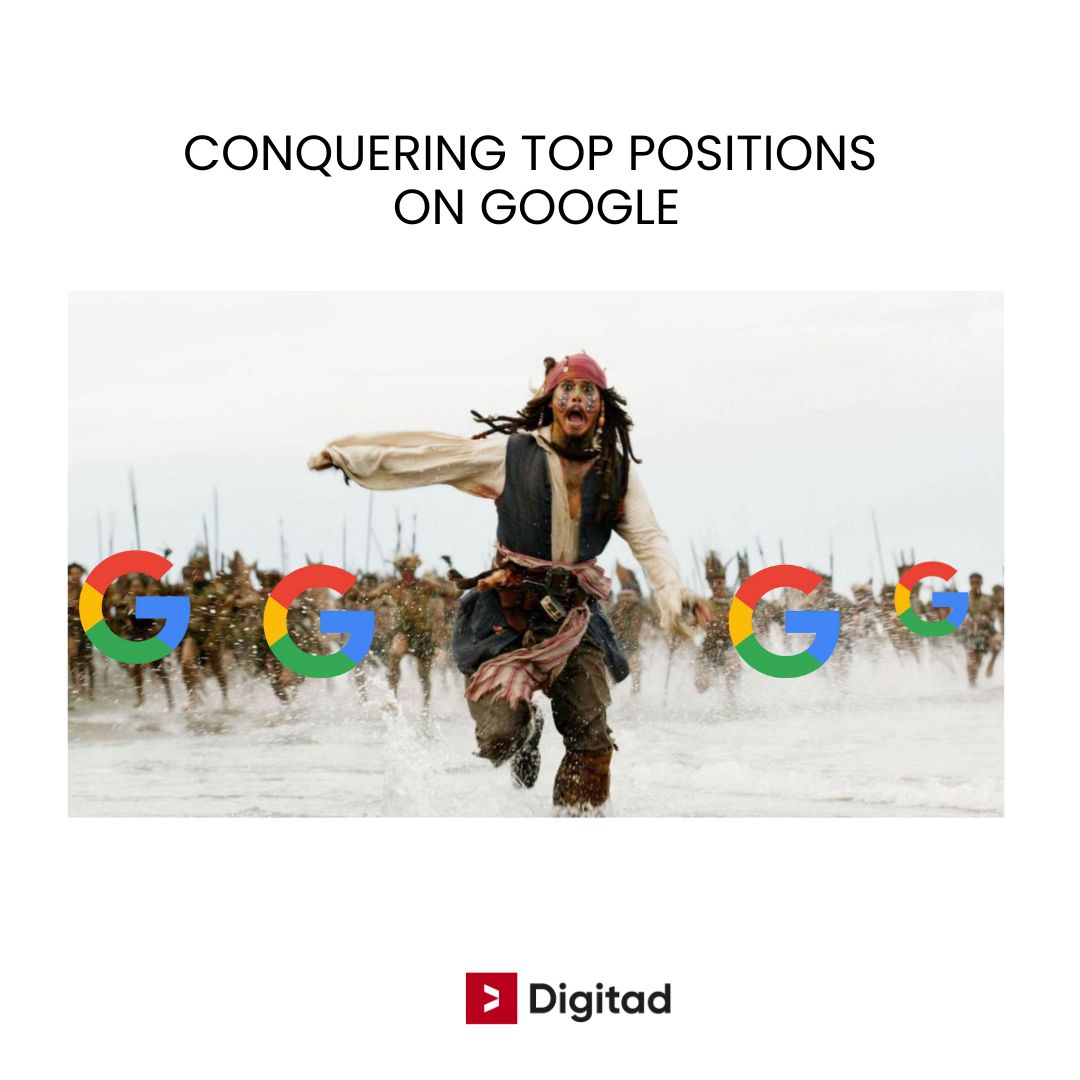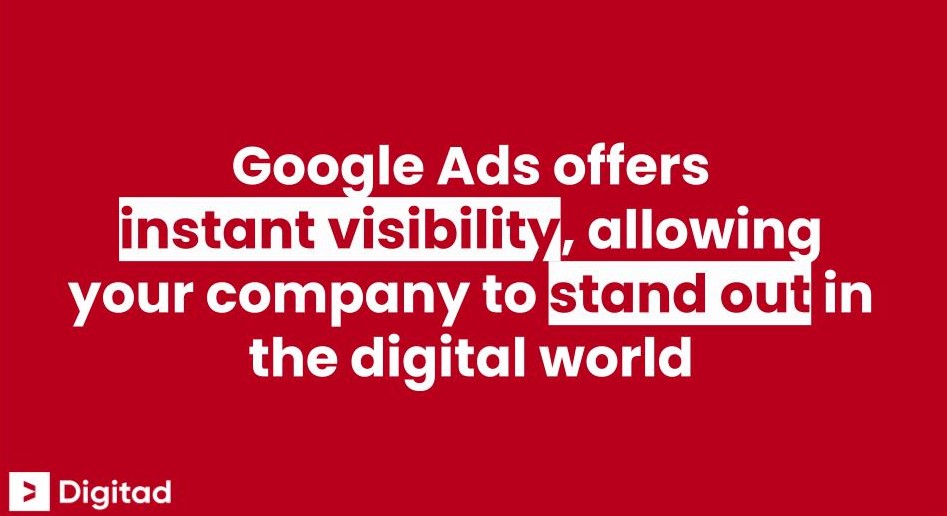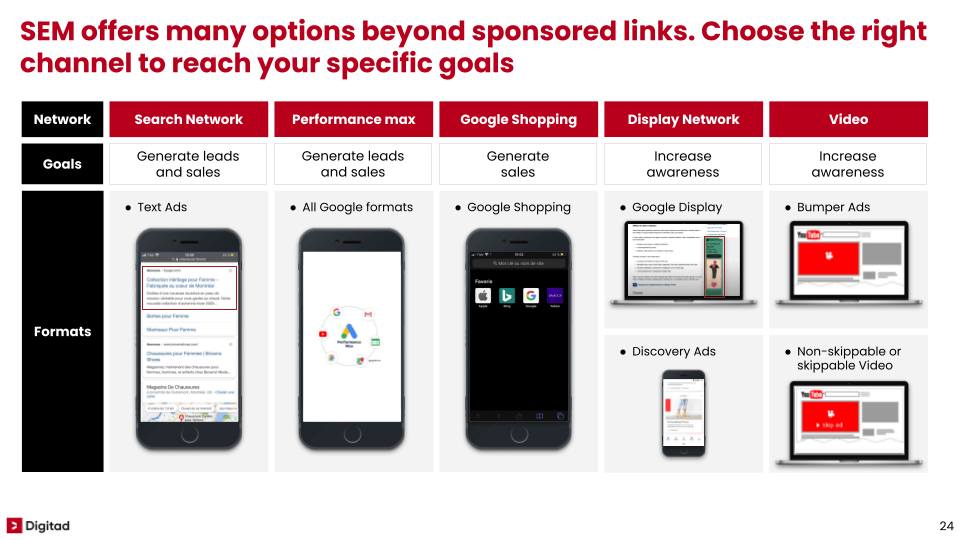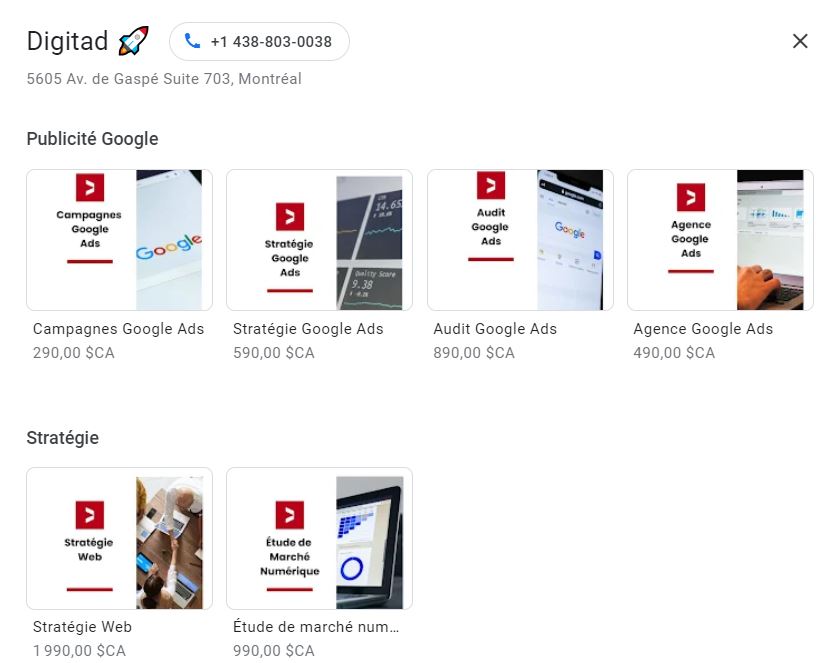Sommaire
- How does Google (and other search engines) work?
- The anatomy of Google’s first page
- Rank on the first page of Google. What are the benefits for your business?
- How to get your business on the first page of Google?
- 1. How to get your business on first page of Google with Google Ads
- 2. How to get your business on first page of Google for free with SEO
- Ready to get your business on the first page of Google?
Want to win in the business game these days? Then you’ve got to show up where it counts: online 😉
And what’s the key arena in this digital landscape? Search engines!
So, are you in the game?
If you’re scratching your head about how to get your business on the first page of Google, or just not sure why you should even care, you’ve hit the jackpot with this guide!
In this guide, our SEO agency in Montreal will cover:
- The inner workings of search engines and their core objectives
- Decoding the anatomy of Google’s first page
- Why landing a first-page spot is a game-changer for your business
- Securing a first-page spot via Google Ads
- The roadmap to climbing Google’s ranks the organic way via SEO, covering:
- Criteria used by search engines
- Actionable steps to aim for the top spot
Ready to crack the code on Google and other search engines? Let’s get started.
How does Google (and other search engines) work?
To get your website to the top spot on Google, you first need to understand what Google is really looking for:

Google’s main goal is to maintain user trust.
Why does this matter? Because the user’s trust turns into dollars. In fact, more than 80% of Google’s revenue comes from Google ads.
So, how does Google win this trust? By giving you the best answers to your questions, whether it’s through paid ads or organic search results.
Google continues to focus on search engine innovation
Google isn’t resting on its laurels; it’s always tweaking things under the hood. Whether you’re searching for “how to bake a lemon cake” or need the weather forecast in your area, Google’s got you covered.
And it doesn’t matter if you’re on your phone, tablet, or even a smartwatch ⌚.
Heads up: Google’s even dabbling in AI-generated search results, according to their latest announcements:
With our new generative AI experience in Search, you’ll get even more from a single search. You’ll be able to quickly make sense of information with an AI-powered snapshot, pointers to explore more and natural ways to ask. #GoogleIO pic.twitter.com/jgzz97DzEv
— Google (@Google) May 10, 2023
Decoding Google’s organic ranking mechanisms
Google employs a multi-faceted approach to rank websites. It involves crawling websites open for indexing. From there, it’s a deep dive into a whole bunch of factors: the techy stuff behind your site, the quality of your content, and how reputable you are in the online world.
What are Google’s ranking criteria?
Rank first on Google doesn’t happen by chance!
The search engine utilizes complex algorithms that consider hundreds of factors to rank search results. These criteria are continually updated—sometimes as often as 500 to 600 times a year.
Here’s a summary of these different Google SEO criteria and their weighting:
So what’s the secret sauce behind Google’s rankings? Meet the Googlebots—these clever algorithms are always on the hunt, sizing up how relevant each web page is for the keywords you’re searching for.
Once they’ve done their detective work, they give you a list known as the “Search Engine Results Page,” or SERP if you want to sound like a pro.
Is my site indexed by Google?
Here’s a quick trick: type “site:yourdomain.com” into Google’s search bar, swapping “yourdomain.com” with your actual domain name.
See your pages popping up in the results? Awesome—you’re on Google’s radar 😃. They know you’re there and they’ll keep coming back to see what’s new.
Not showing up? No sweat. You can nudge Google to notice you with our step-by-step guide. 💡
For personalized SEO strategy support, explore our SEO pricing in Montreal options.
The anatomy of Google’s first page
Google’s first page? It’s like a buffet of different kinds of content. Let’s go over what you’ll usually find:
|
Sections of Google first page |
Description |
| Google Ads Advertising | The top section generally displays 3 or 4 paid text ads. Google chooses these ads based on the keywords used in search queries (Google Ads advertising). |
| Local Map Pack (Google Maps preview) | If Google thinks the user is searching for a nearby local business, it will add a “Local Map Pack”, which is an excerpt from Google Maps. |
| Organic results | The main section is an “organic” (non-paid) list of web pages that are relevant to the keyword used in the search. This list is before, after, or around the local pack. |
A classic example of Google’s first page:
Exploring Google’s diverse content formats
Google’s first page isn’t a one-size-fits-all deal. What shows up depends on a few things: what you’re searching for, what you probably want to know, and the nature of the content returned in the results.
- Wikipedia summaries
- Google Shopping ads
- Business profiles sourced from social media and Google My Business
- Highlighted content previews (also known as optimized excerpts or featured snippets)
- Rich results (annotations, image galleries, videos)
- Suggested related searches
- Latest news via Google News
In this guide, we’re going to focus on the big three result types you’ll see in our visual example. So, why are these formats the ones to watch?
Rank on the first page of Google. What are the benefits for your business?
Landing a top spot on Google’s first page is like striking gold. Over 34% of all search clicks are funnelled to that prime position.
Here’s the deal: if you’re not on Google’s first page, you might as well be a ghost 👻.
Picture it like a shelf in a grocery store. If your site’s front and center, people are going to grab it. But if it’s up high, behind a bunch of other options? Yeah, you’re getting skipped.
Get your website on first page of Google: a channel for visibility and qualified user acquisition
Why should you care about landing on Google’s first page? Getting your business on Google’s first page offers a lot of advantages:
- Amplifies your website’s visibility
- Attracts targeted traffic—people actively seeking solutions
- Boosts user engagement with your content
- Drives conversions, be it online sales or lead generation
- You start looking like a big deal in your field
- Fosters trust among your audience
By the numbers: what does first-page ranking truly mean?
Data reveals that the click-through rate (CTR) distribution varies across the 10 organic links on Google’s first page.
Source : Backlinko
For instance, if 500 people search “Home Decor Store in Montreal” monthly, and you secure the top spot, you could attract 155 solution-seeking visitors to your business each month. Fall outside the top 5, and you’re looking at only 20 prospects—a 7x to 10x drop in potential revenue.
Now, magnify that gap over thousands of queries yearly, and the revenue impact is staggering.
The real opportunity of a top Google ranking for your company
Getting a spot on Google’s first page? That’s like hitting the business lottery. In local markets, it can even make you the go-to name in your field. Bottom line: showing up on that first SERP is a game-changer.
It’s such a big deal that there’s a whole industry—yep, we’re talking SEO—just to help businesses grab those golden spots. And guess what? It works.
Natural traffic to our website since the launch of our web marketing blog in April 2018
When it comes to paid search, click-through rates (CTRs) swing between 2% and 6%. And what you pay per click? That can be pennies or as much as 10 bucks, all depending on how tough the competition is.
So, you’re probably wondering, but how can I rank first on Google? What methods do I use?
Well, get ready, because we’re diving into that million-dollar question right now ⬇️
How to get your business on the first page of Google?
2 proven methods
There are two ways to get your website in first position on Google:
- Using Google Ads (that’s your paid search, pay-per-click, or Search Engine Marketing)
- By moving up the first Google page organically (yep, that’s SEO)
Though they’re different, both methods have a couple of things in common, like targeting the right keywords and nailing your titles. You can use them on their own or mix and match for extra punch.
Want quick results? Go for paid search!
When you launch a paid search campaign, your Google Ads can immediately appear at the top of search results for the keywords you’re targeting —no waiting required. This immediate visibility bypasses the need for search engine discovery and indexing associated with SEO.
Looking for long-term results? That’s SEO!
SEO is a marathon, not a sprint, usually taking a good 3 to 6 months to really kick in. But unlike paid ads, which go poof the minute you stop paying, SEO is the gift that keeps on giving. It’s all about:
- Tweaking your content so it’s top-notch and on point
- Making your site easy to get around
- Speeding up load times for a better user experience
- Sticking to the SEO rulebook
This long-haul approach pays off, winning over both Google and your visitors, and bringing in consistent traffic and sales.
Let’s dive deeper into both strategie
Next, we’ll delve into the specifics of each strategy so you can pick the best way to shoot for that top Google slot.
1. How to get your business on first page of Google with Google Ads
Want the fastest ticket to the top of Google’s first page? Say hello to Google Ads (formerly known as Google AdWords).
Just sign up on Google, pick your keywords, and place your “bid”—that’s how much you’re ready to pay per click. This is what they call “pay-per-click” or PPC.
Worried about going over budget? Set a daily cap, and Google will stop showing your ad when you hit the limit. For most businesses, Google Ads is a quick and budget-friendly way to grab that first-page spotlight.
But heads up: popular keywords cost more. For example, “Travel agency” will hit your wallet harder than “Luxury honeymoon packages in Bali.”
Why Invest in SEM for top Google positioning?
Instantly hit page one
Google Ads shoots you right to the top for hot keywords, no waiting. It’s a fast-pass for getting quality traffic to your site, especially if you’re in a hurry.
Full control over budget
Concerned about costs? Google Ads lets you control your spending down to the penny. You only pay when someone clicks, keeping your budget in check;
Precision targeting
Google Ads is like a sniper rifle for targeting. You can aim your ads at people who are super interested in what you’ve got. You can focus on:
- Where they are (geographic location)
- What language they speak
- What device they’re using
Geo-targeting is one of the most effective targeting options in Google Ads. You can target the countries, regions, cities, and even zip codes that you are most interested in.
Google Ads can also be used at different stages of the buyer journey.
Direct keyword control and rapid campaign optimization
Paid search lets you dictate exactly which keywords will activate your ads. This can be fine-tuned at any time to align with evolving search behaviors or business objectives. Plus, you get instant data to make your ads even better.
How to get started with Google Ads?
If you’re thinking of running a few ads, you can totally do it yourself—if you know the ropes. Check out Google’s own tutorial for a quick start.
Here is a tutorial from Google on how to create your first Google Ads campaign.
And let’s bust a myth: Google Ads isn’t just about those clickable links. You’ve got a ton of different ad formats to play with.
Take your Google Ads to the next level with Digitad
Maximizing the efficacy of your media spend? That’s where we come in. As a distinguished PPC agency in Montreal, we’re all about getting you the best ROI.
Our team knows the ins and outs of Google Ads, and we’re ready to make your campaigns shine.
Not convinced? Compare us to the other agencies. We’re confident you’ll see why Digitad is your go-to for killer Google Ads.
2. How to get your business on first page of Google for free with SEO
Dream of a steady stream of leads landing on your site, and not paying a penny for ads? That’s not a fantasy. It’s called SEO, or Search Engine Optimization.

Going the SEO route? Strap in for the long haul. You’ll need a mix of patience, dedication, and solid strategy to hit that top spot. A successful organic search optimization strategy will require you to post quality content on a regular basis.
It will also require you to spend quite a bit of time on Google Analytics, tracking your performance, running tests, continuously improving, etc.
Here are the main steps involved in SEO:
1. Finding the right keywords
Start by figuring out the search terms you want to rank for. These are your keywords, and they can be single words or phrases. Like:
Here are some examples of keywords:
– “tenant laws”
– “hairstylist near me”
– “brunch Montreal”
– “air conditioning repair”
– “how to plug a leaky roof”
– “how to appear on the first position of Google”
Each page of your website should target a different set of keywords so that your pages do not compete with each other.
The best keywords for you? The ones your ideal customers use when looking for what you offer. They don’t have to be blockbuster terms. Sometimes, longer and more specific keywords—called “long-tail keywords”—are your best bet.
Usually, the longer and more specific a keyword is, the more clearly it conveys the user’s search intent, making it easier to target their needs with your content.
For keyword hunting, Google’s Keyword Planner is your friend. It will enable you to conduct a keyword study, which is an information gold mine that reveals the search behaviour of Internet users in your industry. This research is your SEO backbone, helping you tailor your content over time.
2. Place those keywords strategically
So, how do you wave at Google and say, “Hey, I’ve got the answer!”
Google’s like a librarian. It scans the web, making a giant list of pages in its “index.” When someone searches, Google digs through this index for the best answer.
Your job? Make your site easy for Google to find and understand. Here’s how:
| SEO Element | Optimization Strategy |
Characteristics or Metrics |
| SEO Title (Meta Title) | Place your primary keyword upfront. | 60-65 characters |
| Meta Description | Incorporate primary and secondary keywords. | 130-155 characters |
| Page’s URL | Eliminate superfluous words and include main keywords. | Eliminate useless articles like ‘the’, ‘a’, ‘an’. |
| Content (Length and Density) | Aim for at least 300 words with a keyword density of 0.5% to 2%. | At least 300 words |
| Headings (H1, H2, H3, etc.) | Main keyword in H1. | Use either main or secondary keywords in H2s and H3s. |
| Internal Links | Include logical internal links with descriptive anchor text. Avoid links to words like ‘here’, ‘see’, ‘click’. | “contact our furnishings expert” |
| External Links | Cite at least one high-quality external source. | Government, reputable blog, newspaper, etc. |
| Image Optimization | Add main and additional keywords in the alt attributes or alt text. | N/A |
| Structured Data | Use extensions like Rich Snippets on WordPress or add directly into your page’s code. | N/A |
| Featured Snippets | Include questions in subheadings and answer them directly using numbered lists. | N/A |
Hold up—these nuggets of wisdom aren’t just for blog posts. They’re your all-in-one toolkit for any kind of content: service pages, blog posts, you name it.
Craving for More? Up your content game
Want the deep dive on crafting killer content? Check out our ultimate guide to content writing. Trust us, we’ve been at this for years and our content consistently hits the top spots.
The fine art of keyword balance: stay natural, stay relevant
Look, Google’s no fool. Stuffing your content with keywords like a Thanksgiving turkey? That’s a one-way ticket to the bottom of the search results. The key (see what I did there?) is to weave those keywords in naturally, like a pro.
The golden rule: quality over quantity
Want that coveted spot on Google’s first page? Ditch the keyword confetti. Instead, serve up content that’s not just readable but irresistibly engaging and packed with value. Give your audience what they’re actually looking for, and you won’t just rank—you’ll dominate.
3. Optimize your website’s technical elements
Before diving in, ensure your site is:
- Mobile-responsive, given the surge in mobile search
- User-friendly with intuitive navigation and clear CTAs
- Fast-loading to reduce bounce rates
Here are some technical SEO basics to check before you get started ⬇️
Mobile accessibility
Is your website easily accessible on all devices?
Let’s get straight to the point: If your website isn’t mobile-friendly, you’re already behind. With the lion’s share of searches happening on mobile devices, Google places a premium on mobile-responsive design.
That’s why Google favors mobile-friendly websites. However, if you don’t have an adaptive website, you can make modifications to ensure an optimal experience for the mobile user.
Optimized user experience
Does your website offer a pleasant user experience?
An intuitive site structure with crystal-clear calls to action (CTAs) isn’t just good UX—it’s good SEO. Google’s got its eye on how long users stay on your site. The longer, the better. So, make your website a place people want to hang around.
A website with:
- intuitive navigation
- clear calls to action
- answers to your visitors’ most immediate questions
Makes users want to stay longer and come back later – which Google will notice 👀. This will make it want to rank you higher!
The need for speed
Remember the last time you sat around waiting for a website to load? Neither do I. Speed is a ranking factor.
If your website is too slow, your bounce rate will rise, as potential customers leave your website and Google’s first page moves away for you.
Check your website’s speed in your Google Search Console (a very important SEO tool!) or on the public Google Pagespeed Insights.
In short, you’ll need a responsive, fast-loading site!
Don’t heritage to call our SEO agency in Montreal if you need help with technical SEO, we master it 😉.
4. The power of local SEO
Did you know Google Maps often grabs the top spots in search results? Use this to your advantage.
Create a Google Business Profile
Google Business Profile (previously Google My Business) is one of the most powerful tools for local business owners. Creating a Google Business Profile is a quick and easy way to get your business on the first page of Google for location-based searches.
It’s important to claim and verify your listing to ensure that you can monitor, maintain, and optimize your Google Business profile.
How to rank first on google my business?
Optimize your Google Business Profile
Avoid just creating a listing and hoping it shows up eventually. Google My Business strives to provide consumers with as much information about a business as possible, before they even encounter it. Optimize your Google Business listing for maximum visibility. Here’s how to do it:
- Fill out every section—don’t skimp on details
- Keep your information up-to-date
- Reviews are gold; encourage satisfied customers to leave them
- Photos aren’t just worth a thousand words—they’re worth higher rankings
- Leverage your My Business account to publish news, offers, and updates
- List your products and services. All of them
List your business in other directories
Don’t just rely on Google; platforms like Yelp also carry weight in Google’s eyes.
First, Yelp has high organic traffic and is widely trusted by Google, meaning your company’s Yelp page may very well appear on the first page of Google for relevant searches.
Second, a strong listing with positive reviews improves your overall online presence. Online reviews and quality links from other trusted sites send signals to Google’s ranking algorithm.
As with your Google Business profile listing, make sure all of your listings are complete and accurate, consistent across platforms, up-to-date, and that you are collecting and responding to reviews. Don’t forget to add photos!
The impact of backlinks
Quality backlinks are like a vote of confidence from the web community. The better the backlink, the more Google trusts you.
A quality backlink originates from a high-domain-authority website, and it’s an element that could tip the scales in favor of your website over your competitors.
Acquiring quality backlinks requires time and good backlinks tools, but it will act as a differentiating factor between two competing sites with similar content.
How to get quality backlinks?
Think mutual benefit. Guest posting is an excellent strategy here. By offering quality content to other industry websites, you can earn a valuable backlink in return.
So… a single article can get you a quality link. If you optimize your content creation processes (for example, with AI tools, or always writing long-form list-style blog posts with the same structure), guest posts could produce great results.
Of course, you should take the time to review sites in your industry, select high-authority websites, and make sure the type of content you’re comfortable creating can make for a relevant guest post.
Ready to get your business on the first page of Google?
So, you see, landing on Google’s first page isn’t a fairytale. It’s a perfectly attainable goal, even for small businesses.
All it requires is a meticulously crafted strategy and some hands-on effort.
By mastering these essential steps and techniques, you elevate your online visibility, effectively putting your brand under the limelight it rightfully deserves.
Need a strategic partner? Choose Digitad!
Intrigued by the potential of being on Google’s first page? Reach out to us at Digitad. We’re experts at creating custom plans designed to launch your brand to the top of the digital world.



